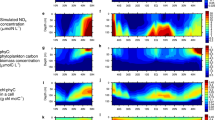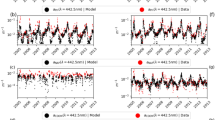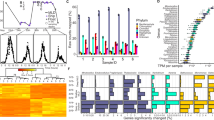Abstract
Bacteriochlorophylla (BChla)-based phototrophy cannot be ignored in understanding of carbon cycle in the ocean. However, the role of BChla relative to chlorophylla (Chla) along environmental gradients remains unclear. On the basis of the investigations in the Pacific, Indian Oceans and the China Seas, we show that the average contribution of BChla relative to Chla is higher in open-ocean compared with shelf environments, the estimated BChla-based phototrophy could reduce respiratory organic carbon consumption of 2.4% and 5.4% of the primary productions in the shelf and oceanic waters, respectively. This suggests that BChla-based phototrophy has an important role supplemental to Chla-based photosynthesis in the ocean's carbon cycle and would be critical for a marine region to be a sink or a source of atmospheric CO2.
Similar content being viewed by others
Log in or create a free account to read this content
Gain free access to this article, as well as selected content from this journal and more on nature.com
or
References
Barber RT, Sanderson MP, Lindley ST, Chai F, Newton J, Trees CC et al. (1996). Primary productivity and its regulation in the equatorial Pacific during and following the 1991–1992 El Nino. Deep-Sea Res Pt II 43: 933–969.
Eiler A . (2006). Evidence for the ubiquity of mixotrophic bacteria in the upper ocean: implications and consequences. Appl and Environ Microbiol 72: 7431–7437.
Gong GC, Wen YH, Wang BW, Liu GJ . (2003). Seasonal variation of chlorophyll a concentration, primary production and environmental conditions in the subtropical East China Sea. Deep-Sea Res Pt II 50: 1219–1236.
Gorbunov M, Falkowski P . (2004). Fluorescence Induction and Relaxation (FIRe) Technique and Instrumentation for Monitoring Photosynthetic Processes and Primary Production in Aquatic Ecosystems. Allen Press: Lawrence, KS (CD-ROM).
Jiao N, Zhang Y, Zeng Y, Hong N, Liu R, Chen F et al. (2007). Distinct distribution pattern of abundance and diversity of aerobic anoxygenic phototrophic bacteria in the global ocean. Environ Microbiol 9: 3091–3099.
Joos F, Plattner GK, Stocker TF, Marchal O, Schmittner A . (1999). Global warming and marine carbon cycle feedbacks on future atmospheric CO2 . Science 284: 464–467.
Koblížek M, Masin M, Ras J, Poulton AJ, Prasil O . (2007). Rapid growth rates of aerobic anoxygenic phototrophs in the ocean. Environ Microbiol 9: 2401–2406.
Kolber ZS, Plumley FG, Lang AS, Beatty JT, Blankenship RE, VanDover CL et al. (2001). Contribution of aerobic photoheterotrophic bacteria to the carbon cycle in the ocean. Science 292: 2492–2495.
Moran MA, Miller WL . (2007). Resourceful heterotrophs make the most of light in the coastal ocean. Nat Rev Microbiol 5: 792–800.
Prentice IC, Farquhar GD, Fasham MJR, Goulden ML, Heimann M, Jaramillo VJ et al. (2001). The carbon cycle and atmospheric carbon dioxide. IPCC report 183–237.
Yurkov VV, Beatty JT . (1998). Aerobic anoxygenic phototrophic bacteria. Microbiol Mol Biol Rev 62: 695–724.
Acknowledgements
We thank Michal Koblížek for his collaboration with us and kindly providing the PSI fluorometer control unit (FL200/PS, Photon Systems Instruments Ltd., Brno, Czechia) for the Indian Ocean leg (2006), LK Hao for sampling on the Pacific leg (2008), YJ Wu for assistance in microscopic analysis. This work was supported by the MOST 2007CB815904, DYXM-115-02-4-3, 200805068 and NSFC 40632013.
Author information
Authors and Affiliations
Corresponding author
Additional information
Supplementary Information accompanies the paper on The ISME Journal website (http://www.nature.com/ismej)
Rights and permissions
About this article
Cite this article
Jiao, N., Zhang, F. & Hong, N. Significant roles of bacteriochlorophylla supplemental to chlorophylla in the ocean. ISME J 4, 595–597 (2010). https://doi.org/10.1038/ismej.2009.135
Received:
Revised:
Accepted:
Published:
Issue date:
DOI: https://doi.org/10.1038/ismej.2009.135
Keywords
This article is cited by
-
Biogeographic patterns of aerobic anoxygenic phototrophic bacteria reveal an ecological consistency of phylogenetic clades in different oceanic biomes
Scientific Reports (2018)
-
Isolation and characterization of the first phage infecting ecologically important marine bacteria Erythrobacter
Virology Journal (2017)
-
Processes of coastal ecosystem carbon sequestration and approaches for increasing carbon sink
Science China Earth Sciences (2017)
-
The research of typical microbial functional group reveals a new oceanic carbon sequestration mechanism—A case of innovative method promoting scientific discovery
Science China Earth Sciences (2016)
-
Mixotrophic growth of bacteriochlorophyll a-containing members of the OM60/NOR5 clade of marine gammaproteobacteria is carbon-starvation independent and correlates with the type of carbon source and oxygen availability
BMC Microbiology (2013)



